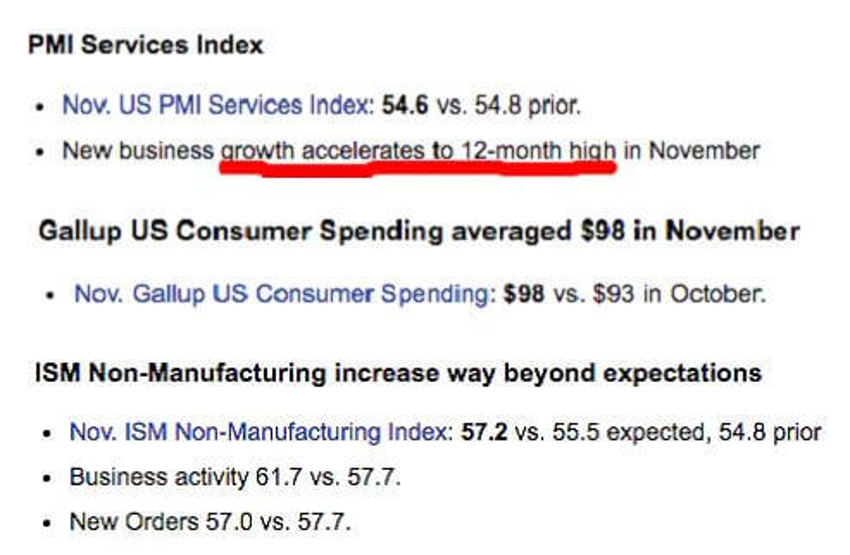Meanwhile, Back in the Real World…
Our view has been that the so-called paltry readings coming from the cylinders of our collective economic engine were most recently being clouded by the energy morass, when oil prices fell dramatically back in June 2014.
And we have many times said that the Q3 2016 earnings season would ring in clearer skies as the worst of the energy setback was round-tripped.
Lo and behold, almost everything is improving in the last few weeks: sentiment, production, manufacturing, orders, PMI's, services, etc., etc.
Let's take a quick review:
The Citigroup Economic Surprise Index jumped from a recent low of -23.8% on October 20 to 24.7% a week passed Friday.
The bad news for fearful investors locked away in bonds is how that data certainly helps to explain why the US Treasury 10-year yield has jumped 77bps over the past 13 weeks.
Dr Ed Yardeni’s own YRI’s Weekly Leading Index (WLI) has soared in recent weeks to a new record high. That index has closely tracked the S&P 500 since 2000, and currently remains quite bullish.
US consumers are enjoying solid employment gains, with payrolls up 2.0 million during the first 11 months of the year, following a 2.7 million rise last year.
Wage gains remain relatively subdued, but that may be because highly paid Baby Boomers are retiring while lower-wage Millennials are entering the labour force.
While average hourly earnings rose 2.4% y/y during November for production and nonsupervisory workers, the Atlanta Fed’s Median Wage Growth Tracker showed a much more solid gain of 3.9% through October.
No wonder auto sales remain at recent cyclical highs, with November clocking in at 17.9 million units. And to think just weeks ago the Bad News Bears were saying Detroit was in trouble.
The US M-PMI rose to a solid reading of 53.2 last month led by its production component, which rose to 56.0, the best level since January 2015.
(This supports the ideas already shared that the economy’s weakness since late 2014 was mostly concentrated in energy-related industries).
Feared recession drivers also seem to have ended in recent months as oil prices have rebounded.
The Atlanta Fed’s GDPNow shows that real GDP rose 2.9% during Q4, based on the currently available indicators for the quarter.
The forecasts of Q4 real residential investment growth and real government spending growth increased from 7.1% to 12.4% and 0.1% to 0.6%, respectively.
The forecasts of real consumer spending growth and real non-residential equipment investment growth recently increased from 2.2% to 2.5% and from 4.6% to 6.6%, respectively.
What does this mean?
It should be a solid and very joyous Holiday Season for all - online and off.
Let's check out a few more tidbits:

"Overvalued" Fears Abound...
Rest assured the chorus of “overvalued” will set off the next series of fears.
After years and years of trudging through quicksand, there will be a huge aversion to the idea that things are speeding up.
And it’s been so long that experts have been telling us that something must be wrong that anything will do.
Terms not heard for over a decade will return to the airwaves, like; inflationary pressures, markets are overheating, investor greed, the fix is in, and the top is here.
So imagine this for a moment:
Think of an environment where markets just generally go up; many days by a tiny amount, others by almost nothing, and still others by a pretty nice leap for the day.
The point here is that those red ink days will be tiny.
As for corrections? Well, in secular bulls like we had in the 1980s and 1990s, corrections were different animals.
It’s my hunch that we are approaching a period where corrections will be very, very short; so much so that they will become the next thing that confuses the investor herd.
Equally, I believe it will still be many years and many thousands of points before that $9 Trillion sitting idle (out of fear) in US deposit accounts budges by all that much.
After all, the sentiment will be that, "At least it’s earning some interest now, eh?"
Whether we choose to accept and trust this or not, the odds are high - and increasing each day - that the US economy, a feeder system for all economies, is shifting into a growth gear we have not seen for an awfully long time.
